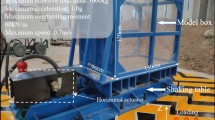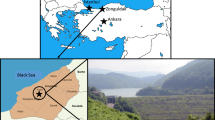Abstract
Concrete dams are one of the most important infrastructures in every country and the seismic safety assessment of them is a major task in dam engineering field. Dam–foundation–reservoir system analysis is a complex interaction problem because this system consists of three domains with different behaviors. For accurate analysis of this system, some important factors should be considered such as foundation mass and earthquake input mechanism. In this paper, the effect of foundation mass and earthquake input mechanism on seismic response of concrete gravity dam is investigated. For this purpose, two different methods are introduced for modeling of massed semi-infinite foundation in finite element method, namely free-field boundary condition and domain reduction method (DRM). To verify the feasibility of proposed methods for seismic analysis of dam–foundation–reservoir system, the displacement and stress outputs using proposed methods are compared with EAGD-84 results. The obtained results indicate that both methods are accurate enough for finite element modeling of massed foundation. Finally, Koyna concrete gravity dam is analyzed for rigid, massless and massed foundation cases using DRM and it is concluded that the foundation has significant effect on dam response and the common massless foundation approach overestimates the dam response.











Similar content being viewed by others
References
Ghaemian M, Ghobarah A (1998) Staggered solution schemes for dam-reservoir interaction. J Fluids Struct 12:933–948
Ghaemian M, Ghobarah A (1999) Nonlinear seismic response of concrete gravity dams with dam-reservoir interaction. Eng Struct 21:306–315
Chopra AK, Chakrabarti P (1981) Earthquake analysis of concrete gravity dams including dam-water-foundation rock interaction. Earthq Eng Struct Dyn 9:363–383
Fenves G, Chopra AK (1984) Earthquake analysis of concrete gravity dams including reservoir bottom absorption and dam-water-foundation rock interaction. Earthq Eng Struct Dyn 12:663–680
Bayraktar A, Hancer E, Akköse M (2005) Influence of base-rock characteristics on the stochastic dynamic response of dam–reservoir–foundation systems. Eng Struct 27:1498–1508
Léger P, Boughoufalah M (1989) Earthquake input mechanisms for time-domain analysis of dam-foundation systems. Eng Struct 11:37–46
Tan H, Chopra AK (1995) Earthquake analysis of arch dams including dam-water foundation rock interaction. Earthq Eng Struct Dyn 24:1453–1474
Tan H, Chopra AK (1995) Dam-foundation rock interaction effects in frequency-response functions of arch dams. Earthq Eng Struct Dyn 24:1475–1489
Chopra AK (2008) Earthquake analysis of arch dams: factors to be considered. In: Proceedings of the 14th World Conference on Earthquake Engineering. Beijing
Fenves G, Chopra AK (1984) EAGD-84: A computer program for earthquake response analysis of concrete gravity dams. Report No. UCB/EERC-84/11. Earthquake Engineering Research Center, University of California, Berkeley
Zienkiewicz OC, Bicanic N, Shen FQ (1989) Earthquake input definition and the transmitting boundary conditions. Adv Comput Nonlinear Mech 300:109–138
Wolf JP (1988), Soil-structure interaction analysis in time domain. Prentice Hall, Upper Saddle River
Galavi V, Petalas A, Brinkgreve RBJ (2013) Finite element modelling of seismic liquefaction in soils. Geotech Eng J SEAGS GSSEA 44:55–64
Itasca Consulting Group, Inc (2004) FLAC (Fast Lagrangian Analysis of Continua). Version 4. Minneapolis
Bielak J, Loukakis K, Hisada Y, Yoshimura C (2003) Domain reduction method for three-dimensional earthquake modeling in localized regions. Part I: theory. Bull Seismol Soc Am 93(2):817–824
Author information
Authors and Affiliations
Corresponding author
Rights and permissions
About this article
Cite this article
Ghaemian, M., Noorzad, A. & Mohammadnezhad, H. Assessment of Foundation Mass and Earthquake Input Mechanism Effect on Dam–Reservoir–Foundation System Response. Int J Civ Eng 17, 473–480 (2019). https://doi.org/10.1007/s40999-018-0325-9
Received:
Accepted:
Published:
Issue Date:
DOI: https://doi.org/10.1007/s40999-018-0325-9




